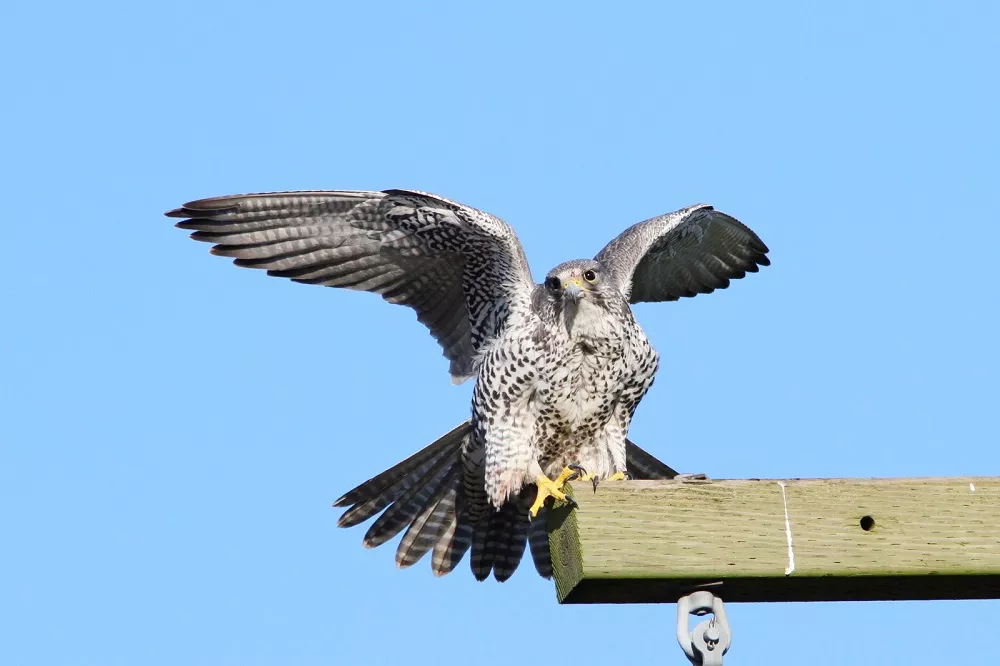Among the awe-inspiring birds of prey, one species stands out as the largest and most majestic of all falcons: the Gyrfalcon (Falco rusticolus). Renowned for its impressive size, strength, and resilience, the Gyrfalcon captivates the imagination of bird enthusiasts and researchers alike. In this article, we will explore the unique characteristics, habitat, and significance of the Gyrfalcon, shedding light on why it holds the distinction as the largest falcon in the world.
Physical Characteristics:
The Gyrfalcon is an imposing bird with a robust build and powerful physique. Adult individuals can reach an impressive length of 48 to 61 centimeters (19 to 24 inches) and have a wingspan ranging from 110 to 130 centimeters (43 to 51 inches). Females tend to be larger than males, as is often observed in birds of prey.
This magnificent species exhibits a variety of color morphs, ranging from a striking white morph to a dark gray or brown morph. The white morph is particularly prized by falconers and is often associated with snowy and Arctic regions, where the species is prevalent. The Gyrfalcon’s plumage serves as excellent camouflage in its icy habitats, allowing it to blend seamlessly with its surroundings.
Habitat and Range:
The Gyrfalcon is known for its affinity for cold, northern environments. It inhabits a broad range across the Arctic and subarctic regions of the Northern Hemisphere, including North America, Europe, and Asia. This remarkable species is found in a diverse array of habitats, including tundra, alpine areas, coastal cliffs, and rocky mountainous regions.
The Gyrfalcon’s adaptability is evident in its ability to inhabit various habitats, ranging from treeless expanses to rocky cliffs and high latitudes. Its wide distribution and habitat flexibility make it one of the most adaptable and resilient falcon species.
Predatory Abilities:
The Gyrfalcon’s predatory skills are as impressive as its physical stature. It is a formidable hunter, primarily preying on a variety of avian species. Its diet consists of ptarmigans, grouse, ducks, geese, and even birds as large as the Willow Ptarmigan, which can weigh up to 1 kilogram (2.2 pounds).
The Gyrfalcon employs several hunting techniques, including both aerial and terrestrial pursuits. It utilizes its remarkable speed, agility, and keen vision to chase down prey in swift and precise attacks. The Gyrfalcon’s powerful talons and sharp beak are well-adapted for seizing and dispatching its avian prey.
Conservation Status:
The Gyrfalcon population is relatively stable, although there may be regional variations due to factors such as habitat loss and disturbances in breeding areas. The species’ adaptability to harsh Arctic environments has contributed to its resilience. However, continued monitoring and conservation efforts are necessary to ensure its long-term survival, particularly in regions where disturbances and climate change may impact its habitat and prey availability.
Cultural Significance and Falconry:
Throughout history, the Gyrfalcon has held a special place in human culture and falconry traditions. Its impressive size and hunting prowess have made it a prized bird for falconers. In medieval times, the Gyrfalcon was considered a symbol of nobility and was exclusively reserved for kings and royalty. Even today, trained Gyrfalcons are highly sought after for falconry activities, representing the pinnacle of falconry achievement due to their strength, size, and hunting capabilities.
Conclusion:
The Gyrfalcon, as the largest falcon in the world, commands respect and admiration with its imposing size, adaptability to harsh Arctic environments, and formidable hunting skills. Its remarkable physical characteristics, range, and cultural significance contribute to its allure and make it a captivating subject of study and conservation.
By understanding the unique features and ecological role of the Gyrfalcon, we gain a deeper appreciation for the intricacies of the natural world and the diverse adaptations of birds of prey. The conservation and protection of this magnificent species are crucial to preserving the ecological balance of its habitats and ensuring the continued presence of this iconic falcon for future generations.


 Facebook
Facebook  Instagram
Instagram  Youtube
Youtube 